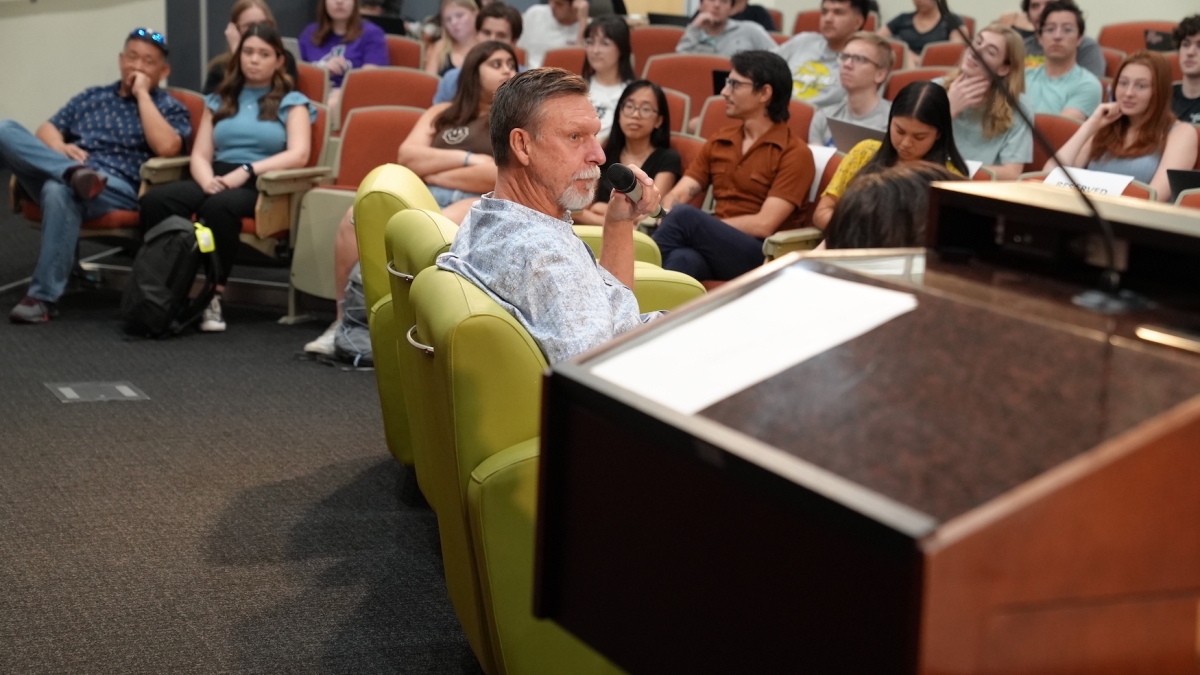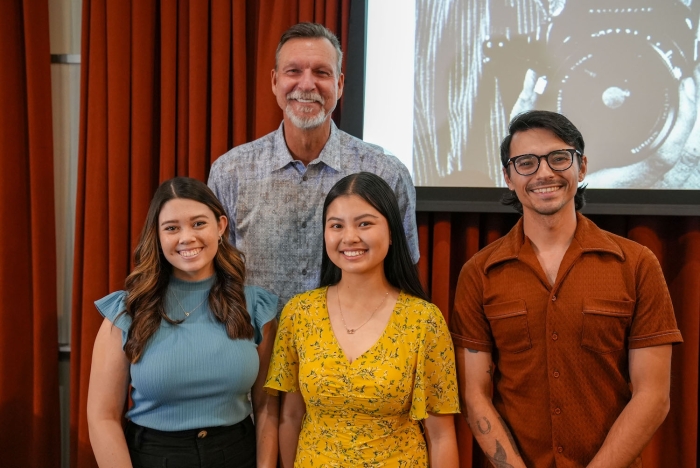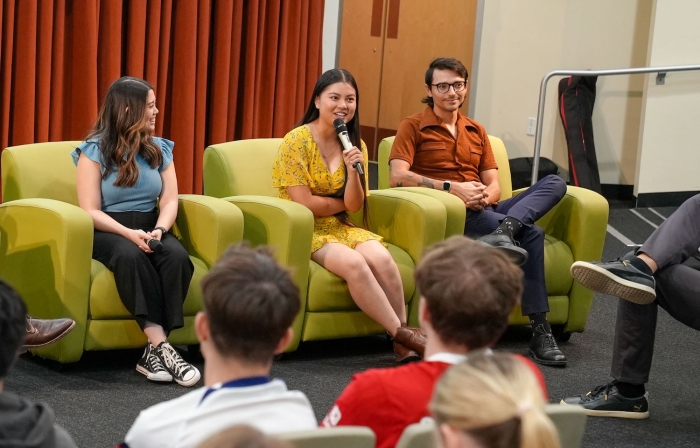‘The Big Unit’ still pitching memorable moments

Former Arizona Diamondback pitcher Randy Johnson was the guest speaker at the Sept. 28 Greg Crowder Memorial Photojournalism Award at ASU's Downtown Phoenix campus. He spoke to Cronkite students about his passion for photography and how it has sustained him since his 2009 retirement from Major League Baseball. Photo by Scott Wholley/ASU
Former Arizona Diamondback Randy Johnson is probably best known for his fastball, with one of his pitches famously clocking in at 102 mph at the peak of his career.
Now he’s got 1/250th of a second to hit the mark.
After 22 seasons in Major League Baseball, the Hall of Fame pitcher known affectionately as “The Big Unit” traded in his mitt for a camera after his retirement and shared his love of photography Thursday at Arizona State University’s Downtown Phoenix campus.
“I studied photojournalism in college, but that had to take a back seat after college, and then I became a professional baseball player,” said Johnson, who was the guest speaker at the Sept. 28 Greg Crowder Memorial Photojournalism Award event, sponsored by the Walter Cronkite School of Journalism and Mass Communication. “When my professional career was over, I was able to get back into photography. I’m really thankful that after my life in baseball I was able to transition to something that I have a passion for and gives me an outlet that takes up my time.”
The award was established in 2010 by Betsy and Troy Crowder to remember their son Greg, a talented photojournalist at The Riverside Press-Enterprise in California and a 1980 graduate of Cronkite who died young. Troy passed away in 2018, and Betsy passed earlier this year. The ceremony Thursday honored the accomplishments of the winners and remembered the memory of Greg, Troy and Betsy.
“We are thrilled the Crowder family honors visual journalism by supporting our talented students through their generous endowment in memory of their late son Greg,” said Emmanuel Lozano, visiting professor of visual journalism who moderated the event. “The Cronkite School of Journalism and Mass Communication values its commitment to empowering future photojournalists in visual storytelling. Greg Crowder’s legacy will forever be a part of the Cronkite Nation.”
Johnson, who recently returned from a photo safari in Kenya, Tanzania and Ethiopia, shared pictures of his trip and some of his rock photography from his Instagram page. He said his passion for photography started in high school and blossomed at the University of Southern California, where he attended college and shot photos for The Daily Trojan, the school's student newspaper.
“That’s where I started studying photojournalism, understanding the dark room and developing film,” said Johnson, who currently has an exhibit of his work in New York and an upcoming February 2024 exhibit at the Scottsdale Center for the Performing Arts. “That opened up a lot of opportunities for me, and at the same time, I’m playing baseball.”
Johnson said he photographed many concerts in the early 1980s and later snapped some of the greatest bands of the rock and metal era — Aerosmith, U2, KISS, ZZ Top, Elton John, Billy Joel, Judas Priest, Rush, Iron Maiden and Guns N' Roses, to name but a few.
He said baseball took up the next quarter-century of his life, but when he retired in 2009, he immediately went back into photography and started traveling around the world, including Rwanda and various countries in Europe. Egypt is now on his radar.
Johnson said he avoids taking pictures of sports, particularly baseball, and doesn’t sell his work to the public. He said there's a rush that comes with taking photos.
“One of the coolest experiences of my life was when I was recently in Ethiopia,” Johnson said. “It was a 12-hour drive into the mountains. You could sleep half a day, wake up and still not get where you’re going. But it was the opportunity to take some great pictures.”
While Johnson was the marquee name at Thursday’s ceremony, it was the three award winners — Samantha Chow, Susan Wong and John Leos — who were the true stars.
The photos they submitted for the award were taken between April 15, 2022, and April 15, 2023. Each winner had to select six to eight photographs to demonstrate a range of their abilities and subjects, including breaking news, portraits, features and sports. The three winners were selected by a committee of professional photojournalists.
Their photos will be exhibited on the third floor of the Cronkite School for the next year. That had special meaning to Chow, who took first-place honors along with $1,000 in prize money.
“Any photojournalist that comes to Cronkite will tell you what that wall on the third floor means,” said Chow, who graduated in May and currently works for ASU as a multimedia specialist. “I remember being a freshman and being in awe of a peer’s work on that wall, and having something to aspire to.”
One of Chow’s most affecting photos was of Connie Cintron, a Tucson woman who placed a rose on her brother Felix Yanez’s casket. Yanez was a private killed in 1950 during the Korean War, and after seven decades, his remains were finally returned to the States in July 2022.
Wong, who won second place, dazzled with an array of seven sports photos.
“What’s special about sports photography are the emotions, intensity and physical motions you can capture,” said Wong, who graduated last year from Cronkite and is a full-time photographer with NASCAR. “But it also has to be digestible to the new fan.”
Wong said she combed through thousands of photos in her archive to choose what she felt was best representative of her work.
“I shot over 50 events in one year, and I had to remember which ones were the most outstanding pictures,” said Wong, who flew in from Charlotte, North Carolina, to attend the event. “But I kind of knew which ones in my brain had some significance to me.”
For Leos, who won third place, he only had to look through one photo session — the trip he made to the Dominican Republic last year. He was there on assignment for the Cronkite Borderlands Project to document the lives of Haitian sugar cane field workers and the impact of U.S. sanctions on the Dominican sugar industry.
“I was there with a mentor, Adriana Zehbraukas, and shot hundreds of photos,” said Leos, who is a graduate student at Cronkite studying mass communication. “I selected photos that I thought would serve the story. Adriana pulled shots that I would not have normally thought of, but showed me these were the types of photos that would draw people in.”
One of the photos was of a recycled American school bus used to transport vulnerable Haitian laborers to the sugar cane fields.
“Half of the photo is smudged because it was taken through the window of a vehicle covered in dirt, which reflects the feeling of obscurity and confusion faced by the workers,” Leos said.
Of the Crowder Award recognition, Leos said it was an honor to be recognized.
“The Cronkite School has so many great student photographers, and I feel fortunate that I’m part of it.”
More Law, journalism and politics
Can elections results be counted quickly yet reliably?
Election results that are released as quickly as the public demands but are reliable enough to earn wide acceptance may not always be possible.At least that's what a bipartisan panel of elections…
Spring break trip to Hawaiʻi provides insight into Indigenous law
A group of Arizona State University law students spent a week in Hawaiʻi for spring break. And while they did take in some of the sites, sounds and tastes of the tropical destination, the trip…

LA journalists and officials gather to connect and salute fire coverage
Recognition of Los Angeles-area media coverage of the region’s January wildfires was the primary message as hundreds gathered at ASU California Center Broadway for an annual convening of journalists…



